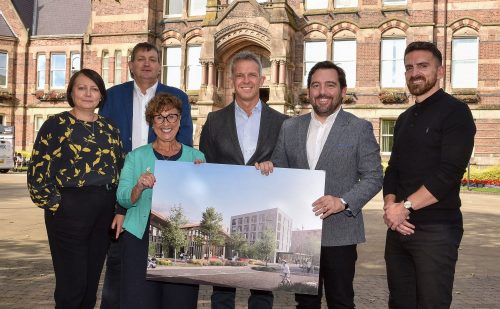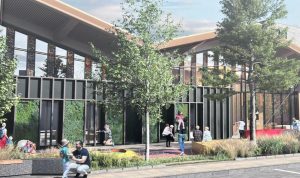The Hard Hat Hi-Vis tour: St Helens

Where are we? St Helens.
Who are we with? Senior regen officers Lisa Harris and Sean Traynor from St Helens Borough Council, and Stuart Rogers from developer Muse.
First impressions: As run down town centres go, St Helens is definitely in need of a tidy up, a refresh and a new sense of purpose.
And how will they do that? Ex Terra Lucem.

Stuart Rogers
You what? It’s the Latin motto for the town, from the ground comes light, a nod to the coal mining and glass industry heritage, something everyone is very proud of.
Local people definitely feel the town centre is on the down, says Rogers, who’s job it is to create a project that lifts the fortunes and purpose of the town centre again.
Traynor says, “we recognise there have been a number of false dawns, two or three times over. The challenge was to identify a partner that had a track record of delivery that could bring in other partners and do the hard work of convincing the public of St Helens they were serious.”
So what’s happening? Funding support has been provided for St Helens town centre, where a new 25,000 sq ft Market Hall is set to be the first phase centrepiece of a transformational regeneration scheme. Together with partners, the English Cities Fund (ECF) – the Council are bringing forward plans for a new Market Hall as the centrepiece of a transformational mixed-use area that includes a 120-bedroom globally branded hotel, 75,000 sq ft of office space, 64 new homes and 11,000 sq. ft. modern retail space in the initial phase.
The project represents the biggest ever single investment in St Helens town centre and involves the Council itself committing a £69.2 million package to Phase One.
Backing is also being made available in the form of £21.49 million in grants from the UK Government and equity investment by ECF. Specifically, there are two related UK Government Town Deal grants totalling £10.49 million. The Phase One proposals have also been awarded £0.812 million from the One Public Estate Brownfield Land Release Fund to help deliver the residential element. In addition to this backing, the Liverpool City Region Combined Authority has also provided financial support for the new St Helens bus station, which will be extended and renewed with a new modern interchange to encourage public transport and active travel usage.
A globally branded hotel? In St Helens? Traynor: “yes, everyone’s surprised by that, but it’s a direct response to intelligence we got. We checked out local stakeholders who support the idea of a high quality hotel for the business sector and part of a wider ambition to continue attracting businesses to the town.”
Who is it? “Can’t say”.
And plans for a speculative office development, where’s the demand? Traynor: “CBRE did some research for us, there are a number of lease breaks coming up in major employers in the public and private sectors, but we don’t just want any old block, but the greenest office building in the country. We’ve talked to local businesses with an ambition to grow and there just isn’t the quality accommodation they need.”

Glass Futures Global Centre of Excellence
Hasn’t St Helens got a decent out of town retail park and a new stadium for the Rugby League club, and the Glass Futures centre? It has indeed, but while a lot of higher quality retail has moved there, the town centre is hollowed out. Glass Futures, as Traynor says, has helped put St Helens back on the map.
An artisan market? Not exactly, funding support has also been provided in St Helens town centre, where a new 25,000 sq ft Market Hall is set to be the first phase centrepiece of a transformational regeneration scheme. Traynor: “Hospitality businesses are typically the anchor, with a range of businesses from bars to coffee shops to street food kitchens. Street food units have the potential to make the biggest financial contribution, operating on turnover rents in which a percentage of the trader’s net income is paid to the market operator in rent. It follows that we have to get the balance right; too many street food units and the maximum income levels for the businesses could become unviable. Too few, and the venue would risk lack the diversity and variety to attract strong footfall levels.”
So they’ve clearly thought this through? Traynor again: “Britain’s market towns face remarkably similar challenges when it comes to adapting to changing shopping habits and creating spaces that serve the community well. On the one hand, out-of-town parks and 24/7 online retail continue to redefine the High Street. On the other, if you are lucky enough to live somewhere with a market tradition, there’s often a sense that a market itself is a trump card that can serve as a catalyst for creating an attractive, sustainable, and family-friendly environment.”

CGI of St Helens town centre plans
Not a one-size-fits-all off-the-shelf-regen scheme then? “One of the biggest drivers of the entire town centre regeneration project we are delivering is ensuring that everything retains a sense of local heritage and what we call ‘St Helens-ness’,” says Traynor. “So the structure of the new Market Hall will reflect the town’s original market constructed in 1850. The design features stained-glass windows to reflect St Helens long standing status as a world leader in glass making. Smaller details include plans for inscriptions of St Helens heritage in stone along footpaths leading to the site, specially designed glass detailing into outdoor seating and educational signage to provide information about St Helens’ history.”
Who’s building it? Vinci have been appointed with a big nod towards local job creation and social value impact, claiming “we will deliver significant social value in direct support of the Council’s recently adopted Inclusive Growth Strategy. Phase one as a whole is expected to have a strong impact in terms of employment and Gross Value Added (GVA) – some 485 new jobs across the development once it is fully occupied, generating £23.2 million GVA each year.”
Will all the new buildings be glass clad? Maybe, but the developer has done a deal with NSG Pilkington, the global glass giant with an enormous base in the town, to supply constructor Vinci with low carbon glass at the price as regular glass.
But councils are skint, what can they do? They can’t afford to do nothing. So at the back end of last year St Helens Borough Council’s cabinet signed off a £69.2million package confirmed for Phase One A of the large-scale transformation project it is bringing forward in partnership with The English Cities Fund (ECF), which Muse run.

St Helens approves regen scheme
Photo caption – from left to right:
Lisa Harris, Executive Director of Place Services, St Helens Borough Council
Cllr Richard McCauley, Cabinet Member for Regeneration and Planning at St Helens Borough Council
Kathy O’Dwyer, Chief Executive, St Helens Borough Council
Phil Mayall, Regional Director, The English Cities Fund
Cllr David Baines, Leader, St Helens Borough Council
Stuart Rogers, Development Director, The English Cities Fund







